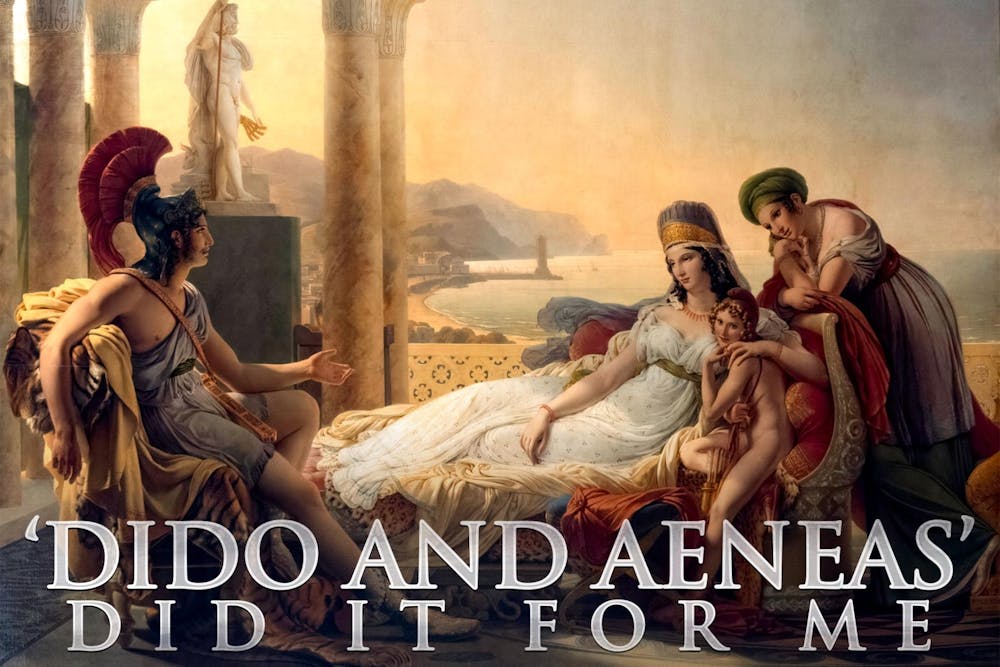What’s the difference between an opera and a musical? I can think of two answers, besides the obvious ones. The first is that people clap longer after operas than they do after musicals. (In the classical music world, everything gets a standing ovation — this neurosis hasn’t spread to the musical theater world … yet.) The second is that an opera is 50 to 100% longer than a musical. Maybe it’s because the audience for opera these days is mostly retirees, a demographic which can make time for a four-hour performance — it’s not like they have much else going on.
“Dido and Aeneas,” presented by Opera Notre Dame last weekend, got the standard opera-length applause but — unlike your stereotypical work by Wagner or Verdi or whoever — is a mercifully short piece. It doesn’t drag its feet, lasting no longer than 75 minutes.
Consequently, the vocalists and instrumentalists were able to jam-pack every second with aural excitement. The opera was clearly well rehearsed — i.e., I scarcely noticed a note out of place.
The orchestra mixed baroque-and modern-style instruments. Music director Dror Baitel conducted from the harpsichord. The basso in the basso continuo section was handled by Phillip. W. Serna, whose consistent violone-playing gave the ensemble momentum. Baroque-style bass sonorities can get fuzzy and awkward — and I often wish historical accuracy were sacrificed for the solid sound of modern cellos and double basses — but Serna played with remarkable exactitude and elegance leaving no room for complaints. The theorbo, a sort of massive lute, was a welcome addition to the ensemble. The violinists and violist played so well and with such richness that they sounded like a lot more than three musicians (no “historically-informed” “senza vib.” here!).
All of the singers were good matches for their roles. Vivian Ng made a great Belinda — the kind-hearted, softly smiling companion of Dido and her bosom to rest upon. The Sorcerer, portrayed by Reece Connors, had a hefty voice and was convincingly wicked. (The decision to costume him in a kilt was inspired — there’s something unsettling about a malicious man in a plaid skirt.) The Sailor, played by Hyunwoo Lee, did “Come away, fellow sailors” and its glib Stuart Era antics justice. As the Spirit, Wynona Wan starred in a well-staged, well-costumed and well-sung deus ex machina moment.
Seth Hobi was a charming and martial Aeneas, and his final back-and-forth with Dido was particularly heart-rending. Grace Parry Hancock was splendid, and her rendition of “Dido’s Lament” brought the house down — but how can a song like that not!
The two Witches (Gianna Macedon and Julia Bezems) demand special attention. Their singing was bright and colorful, and their characterizations of the roles were hilarious. They fully committed to the hunching and cackling and plotting and scheming. It was kitschy, and that’s why it rocked. In this way, the production really worked — i.e., when it kept to campy witchcraft imagery and charming Caroline pastoralism.
But according to the stage director’s note in the program, this production wasn’t about kitsch. Rather, it was about “the profound personal toll of war,” “the immense forces of war and conflict” and “the flames of destruction ignited by greed.” Watching the show itself and ignoring the program, though, I’d be more inclined to say that “the flames of destruction” were ignited by two hilarious witches and not “greed.” In general, these heady gestures fell flat for me.
(I’ll concede, however, that “Dido and Aeneas” has never quite been an opera for opera’s sake. Nahum Tate’s 1680s libretto does seem to allegorically associate the Witches with the contemporary Catholic Church.)
Nevertheless — despite the campiness of the witches and the intellectualism of some of the staging — Dido, Aeneas and the Sorcerer were directed into delivering genuinely down-to-earth, emotional and moving performances. I also loved the artworks projected onto the background and the corresponding tableau vivant scene design. Still, the broader attempt to connect “Dido and Aeneas” to wars of the 20th and 21st centuries felt forced.










